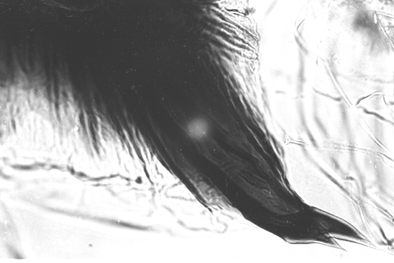C. 'timmsi' manuscript nameLarva: a medium sized bathophilus-type (about 18-19 mm); ventral tubules well developed, anterior pair longer 0.94 to 0.88 mm). Anal tubules about 400 µm long and about 3 times longer than wide.Gula and frontoclypeus pale.
Mentum (Fig. c) with fourth laterals slightly reduced (type I-II); c2 teeth of centre trifid tooth well separated (type IIA).
Ventromental plates (Fig. d) separated by about one third of the mentum width, each with about 35 - 45 striae, VMR about 0.3 - 0.33. Pecten epiparyngis (Fig. a) with about 11 - 18 sharp pointed teeth.
Premandible with teeth about equal length, inner tooth about 2.1-2.75x wider than outer tooth.
Antenna (Fig. b) relatively short, Ring organ about 0.35-0.46 up from base of A1, which is about 3 - 3.6 times as long as wide, AR about 1.95 - 2.3, antennal proportions (microns) 146 : 36 : 9 : 13 : 7.
Mandible (Fig. e) with third inner tooth only slightly darkened and not completely separated (type IIB), about 13 - 16 striae on the outer surface near the base. Cytology: 4 polytene chromosomes with the pseudothummi arm combination AE, BF, CD, G.
Centromeres somewhat heterochromatic and vacuolated on the AE and CD chromosomes. These vacuolated centromeres sometimes form loose connections with those of other chromosomes through diffused heterochromatin (see bottom left of chromosome figure). Banding patterns of arms B, C, and D quite difficult to recognize.
Arm G paired, with an essentially terminal nucleolus with a heterochromatic cap, probably with a BR close by, and a BR just before the middle of the arm.
No polymorphism in the two specimens available.
timA1: 1a-e, 9 - 8, 2d - 3e, 1f - 2c, 10 - 11, 3f-i, 12c-a, 4 - 7, 13 - 19
timB1: Puff with dark bands proximal (groups 7-8), about one third from distal end of the arm.
timC1: Characteristic bands (groups 3-4) about a third from distal end.
timD1:
timE1: 1 - 3e, 10b - 3f, 10c - 13 as oppositus E1
timF1: 1 - 2a, 10 - 6, 13c - 11, 2b - 5, 13d - 23
timG1: Nucleolus terminal but for heterochromatic cap, BR near middle of the arm. Pupa: Exuviae relatively pale, brownish, length about 10.6 mm (female), 10-13 mm (male); length of inner margin of wing case 2.1 mm (female), 2.2 mm (male).
Many characters are summarised in the Table below, with additional information here:
Cephalic tubercles about twice as long as wide. Respiratory base about 142-164 µm long, with the tracheal patch markedly narrowing in the centre. Anterior to the base there is a patch containing 2 or 3 loops and 2-3 setae.
Hook row on posterior margin of tergite II occupying about 55-60% of the width of the segment. Pedes spurii B well developed laterally on segment II, smaller on segment III; pedes spurii A well developed on segment IV, but small and distinct on V and VI. L-setae present at the junction of segments III/IV and IV/V, arising from the posterior margin of the anterior segment, the setae are difficult to measure but generally seem to be about 100 µm long, possibly longer at the IV/V junction.  Caudolateral spur of tergite VIII with one or two spines. Caudolateral spur of tergite VIII with one or two spines. | | | Females (1) | | Males (4) | | | Mean | Range | Mean | Range | | Length (mm) | 10.6 | 10.6 | 10.25 | 10.0-10.7 | | Inner margin of wing case | 2.09 | 2.09 | 2.18 | 2.15-2.20 | | Cephalic tubercles (µm) | 60 | 58-61 | 72.8 | 63-86 | | Cephalic bristles (µm) | 55.5 | 53-58 | 55.8 | 50-60 | | HR | 2.3 | 2.2-2.5 | 2.6 | 2.0-3.0 | | Len. PSA of abd seg IV (µm) | 220 | 218-220 | 218 | 185-240 | | Hooks on abd. segment II | 89 | 89 | 97 | 90-106 | | Swim fin taeniae (one side) | 123 | 123 | 115 | 107-121 | [ Return to Index | Go to References ] |
